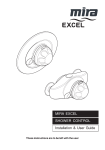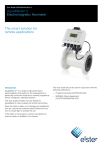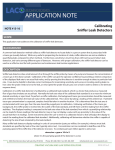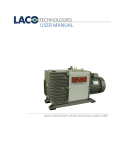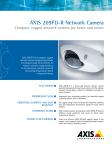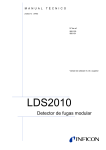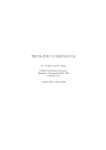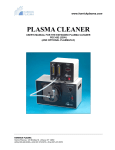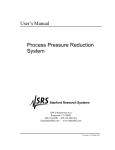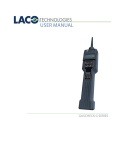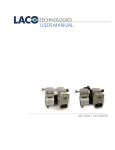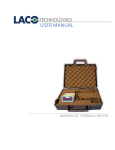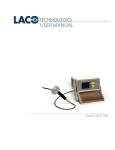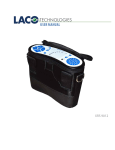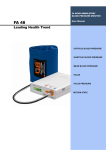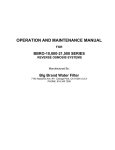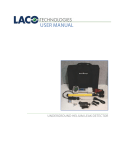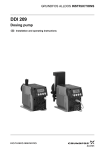Download SMT-07-1014 revA2 (Calmaster User Manual).indd
Transcript
USER MANUAL CALMASTER™ LEAK STANDARDS CONTACT US PHONE/FAX Toll Free: 800.465.1004 Phone: 801.486.1004 Fax: 801.486.1007 ADDRESS LACO Technologies, Inc. 3085 West Directors Row Salt Lake City, UT 84104 WEB www.lacotech.com [email protected] SMT-07-1014 rev A2 ii © 2010 LACO TECHNOLOGIES, INC. CONTENTS 1. SCOPE ................................................................................... 1 2. SAFETY ................................................................................. 1 3. OVERVIEW............................................................................ 2 4. BASIC OPERATION ............................................................. 4 5. MAINTENANCE ................................................................. 10 6. CALIBRATION OF LEAKS ................................................. 10 7. SHIPPING INSTRUCTIONS .............................................. 11 8. WARRANTY INFORMATION............................................ 11 9. APPENDIX A: LEAKS WITH PRESSURE GAUGES......... 12 10. APPENDIX B: LEAKS FLOWING TO ATMOSPHERE ..... 13 iii © 2010 LACO TECHNOLOGIES, INC. LACO USER MANUAL - CALMASTER™ LEAK STANDARDS 1. SCOPE This manual contains safety, operation, and maintenance information for CalMaster™ Leak Standards. LACO leak standards are designed to ensure safety when used properly. It is the responsibility of the user to follow safety-related warnings, cautions, notes, and other requirements described in this manual. LACO Technologies, Inc. is committed to full customer support of every aspect of its CalMaster™ Leak Standards. Call or email LACO for technical sales and support. 2. SAFETY The following safety precautions should always be followed. LACO Technologies, Inc., is not responsible for damage to persons or equipment that results from improper or inappropriate use of a leak standard. Figure 1: Leak Standard Seal Table 1: Safety Precautions COMPONENT PRECAUTION TAMPERRESISTANT SEALS Do not open or break tamper-resistant seals. VENTING When venting a refillable reservoir, point valve away from face, body, and other people. For refill instructions, see 4.2 REFILLING. PRESSURIZING RESERVOIRS DOT-approved reservoirs (which are clearly marked on the outside of the bottle) can be safely pressurized to 1800 psig, while all others have a maximum pressure rating of 400 psig. WARNING Do not over-pressurize a refillable reservoir. Special precaution should be taken regarding certain LACO Technologies custom fill valves having metal/ solder tamper-resistant seals (see Figure 1). Under no circumstances should this seal be broken, loosened, melted, or removed. Doing so may result in serious injury to persons or damage to property. Should this seal be compromised by accidental or other means, contact LACO Technologies immediately for further safety precautions. MAINTAIN SEAL INTEGRITY WARNING Do not attempt to re-pressurize a reservoir that was not designed for user-refilling. GASSES Do not use gas other than what is specified on the calibration label and certificate. HAZARDOUS GASSES Do not use toxic or hazardous gases with any leak standard. LEAK STANDARD CARE Do not drop, throw, puncture, incinerate, or otherwise compromise a pressurized reservoir. Do not re-pressurize a reservoir that has been damaged. TEMPERATURE Do not heat reservoir above 50°C; do not cool below 0°C. LEAK STANDARD DAMAGE If physical signs of damage to a leak standard are evident, discontinue use and return it to the factory for repair. 1 © 2010 LACO TECHNOLOGIES, INC. LACO USER MANUAL - CALMASTER™ LEAK STANDARDS 3. OVERVIEW A leak standard is a device that, under prescribed conditions, emits a controlled flow of a specified gas. This device consists of a leak element (either a physical orifice or a gas-permeable membrane) that allows gas to pass through to the outlet of the device at a controlled rate. That rate, called the leak rate can be accurately quantified by means of calibration. 3.1 SPECIFICATIONS Table 2: Leak Specifications TEFLON GLASS CRIMPED CAPILLARY MICRO-TUBE CAPILLARY GAS Helium Helium Helium/Other gases* Helium/Other gases* LEAK RATE RANGE 10-8 to 10-3 atmcc/sec 10-10 to 10-7 atmcc/sec 10-7 to 10 atmcc/sec 10-9 to 1 atmcc/sec 0.1%/°C (Reservoir-style) TEMPERATURE COEFFICIENT 2.0 % / ºC DEPLETION RATE Target value: <3%/year; actual depletion rate is dependant on pressure, reservoir size and leak rate. CALIBRATION UNCERTAINTY Refer to section 3.1.10 Uncertainty 4.0 % / ºC 0.2 % / ºC -0.5%/°C (Open-style) *Non-hazardous, non-radioactive Most of LACO CalMaster™ leak standards now feature our proprietary micro tube capillary leak elements. Our micro tube capillary has undergone a rigorous validation process to verify the reliability of the leak standard. Table 3: Leak Element Comparison LEAK ELEMENT GASES LEAK RATE TEMP COEF. CLOGGING VACUUM RESPONSE STABILITY DURABILITY PRESSURE RESPONSE Glass Helium Only 10-7 - 10-10 Permeation 4% per °C None Fair Excellent Breakable Fair Teflon Helium Only 10-4 - 10-8 Permeation 2% per °C None Fair Fair Unbreakable Fair Metal Capillary All Gases 10-1 - 10-6 0.2% per °C Frequent Excellent Varies Unbreakable Excellent Micro Tube Capillary All Gases 10-1 - 10-10 0.1 % per °C Very Rare Excellent Excellent Unbreakable Excellent 2 © 2010 LACO TECHNOLOGIES, INC. LACO USER MANUAL - CALMASTER™ LEAK STANDARDS 3.2 MAKEUP OF A LEAK STANDARD NOTE For available CalMaster™ leak standard configurations, please contact a LACO Technologies sales engineer. Figure 2: Sample Leak Standard 3.2.1 INLET PORT OR FILL VALVE The presence and types of inlet ports or fill valves depends upon the requirements and style of the leak standard. Leaks standards that require periodic re-pressurizing are typically supplied with a pressure gauge as part of the leak standard, while leak standards that have an external gas pressure source will not (with some exceptions) have a pressure gauge supplied. Still, other leak standards have factory-sealed fill valves and are designed to be re-pressurized only by the factory. 3.2.2 PRESSURE GAUGE A pressure gauge may be supplied with the leak standard and is typically supplied with leak standards designed to be re-filled by the customer. For refill instructions, see Section 4.2 REFILLING. 3.2.3 LEAK ELEMENT LACO Technologies uses four types of leak elements: • Micro-tube capillary (a physical orifice) • Metal capillary (a physical orifice) • Glass permeation (a solid glass membrane) • Teflon permeation (a solid Teflon membrane) 3.2.4 RESERVOIR. All leak standards require a supply of gas; some have a built-in reservoir that contain a supply of gas, while others, having no built-in reservoir, need an independent, regulated supply. These are typically called openstyle leak standards. 3.2.5 OUTLET PORT/CONNECTION Depending upon the leak style, the outlet port of the leak standard is connected to a vacuum system, leak detector, or some other process system. Or, a sniffer probe is placed near or inside the port. 3.2.6 ISOLATION VALVE An isolation valve at the outlet port may be supplied for convenience in operating the leak standard. Leak standards are available in many types and configurations. Proper use and care of a leak standard is dependent upon its type and style. 3 © 2010 LACO TECHNOLOGIES, INC. LACO USER MANUAL - CALMASTER™ LEAK STANDARDS 4. BASIC OPERATION 4.1 USING INFORMATION ON LABEL All leak standards include a calibration label bearing important calibration information; where size permits, important physical data regarding the leak standard is also included. In all cases, such information is also found on the calibration certificate. Figure 3: Leak Calibration Label 3085 West Directors Row Salt Lake City, UT 84104 Calibrated Leak Standard 801-486-1004 • lacotech.com Mod No: Sample Leak Temp: 23.0°C Ser No: Sample SN Temp Coef: 2.0%/°C Cal No: 721338 Cal Gas: Helium Cal Date: 1 Jan 2010 Depl Rate: 15%/year Due Date: 1 Jan 2011 Leak Rate (atmcc/sec) 5.00 x 10-7 ±8.0% into vac Table 4: Label Information COMPONENT DESCRIPTION MODEL NUMBER A number that denotes the specifications of the leak standard, including (but not limited to) leak element type, calibration gas, nominal leak rate, number of calibration points, isolation valve type, reservoir type, and connection type. SERIAL NUMBER A unique number that identifies the leak standard. CALIBRATION NUMBER A number unique to the calibration of the leak standard and its resulting data, and which identifies that calibration. CALIBRATION TEMPERATURE The temperature at which the calibration was performed. Because temperature affects leak rate (see Temperature Coefficient below), calibration temperature is an important factor. Leak standards should be used within a window of ±10°C of the calibration temperature. TEMPERATURE COEFFICIENT A constant that allows for a leak rate correction when the leak standard is used at a temperature other than the calibration temperature. The correction is made using the following equation. EQUATION 1: WHERE: QCOR is corrected leak rate (in the same leak rate unit that is on the label), QCAL is leak rate on calibration label, CT is temperature coefficient on label (%/°C), T is ambient temperature at time of leak standard use (°C), TCAL is calibration temperature on label (°C). 4 © 2010 LACO TECHNOLOGIES, INC. LACO USER MANUAL - CALMASTER™ LEAK STANDARDS Table 4: Label Information COMPONENT TEMPERATURE COEFFICIENT (CONT’D) DESCRIPTION EXAMPLE: The label on a leak standard shows a leak rate of 2.00 x 10-6 atmcc/sec, a calibration temperature of 23.0°C, and a temperature coefficient of 2.0%/°C; the ambient temperature during use of the leak standard is 21.0°C. The corrected leak rate value, according to the above equation, is: CALIBRATION GAS Gas used in the leak standard and gas used in calibration. CALIBRATION PRESSURE Gas pressure needed to achieve the leak rate on the label. For open-style or refillable leak standards, this pressure must be supplied during use. Do not exceed this pressure, as doing so may damage the leak standard and/or cause personal injury. Pressure in leak standards supplied with a pressure gauge should be monitored and refilled using the supplied gauge as the pressure reference (not a different gauge), as calibration of the leak standard was performed using the supplied gauge. Open-style leak standards not supplied with a pressure gauge should be pressurized using a reference pressure gauge that has been calibrated traceable to national and international standards (e.g. NIST). In many cases, the calibration pressure is denoted in relative terms (e.g. PSIG), meaning atmospheric pressure variations (due to elevation) affect this value. A correction factor to the pressure may need to be applied in these cases. The calibration certificate will note when a correction factor may be needed, and document LF-110, “Addendum to Calibration Certificate—Leaks with Pressure Gauges” is included with the certificate as a reference for making this correction. See Section 10. APPENDIX A: LEAKS WITH PRESSURE GAUGES for details. DEPLETION RATE This applies to leak standards with reservoirs. Such leak standards have an included gas supply that depletes over time. The leak rate of all leak standards is dependent largely upon the pressure of the gas supply; as that supply diminishes, so does the leak rate. The depletion rate on the label, expressed in terms of percent of leak rate per unit time, allows the user to account for this depletion and estimate a corrected value (as well as determine an adequate recalibration interval; see below). The correction is performed using the following equation. EQUATION 2: WHERE: EXAMPLE: QCOR is corrected leak rate (in the same leak rate unit as on the label), QCAL is leak rate on calibration label, DR is depletion rate on label (usually %/year), T is approximate time in months since calibration. The label on a leak standard shows a leak rate of 2.00 x 10-5 atmcc/sec, with a depletion rate of 5.0%/year and a calibration date of Jan. 1, 2004. If the current date is July 1, 2004, the corrected leak rate of the leak standard is 5 © 2010 LACO TECHNOLOGIES, INC. LACO USER MANUAL - CALMASTER™ LEAK STANDARDS Table 4: Label Information COMPONENT DESCRIPTION DEPLETION RATE (CONT’D) Depletion rate is an important factor in determining recalibration intervals for leak standards. In general, the higher the depletion rate, the lower the recalibration interval should be. Many leak standards are equipped with an isolation valve; while storing such a leak standard with the isolation valve closed may reduce the depletion rate in some cases, this technique should not be considered an alternative to recalibration, or justification to disregard depletion rate. Where depletion rate is a significant issue, a special valve, called a “zero-volume” valve, can be supplied with new leak standards. When kept closed during non-use, a zerovolume valve effectively reduces the depletion rate to zero. LEAK RATE The measured value of the leak rate of the leak standard, as determined by calibration. Leak rate values are also expressed in terms of the outlet pressure conditions, which are typically vacuum or atmosphere. APPENDIX B: LEAKS FLOWING TO ATMOSPHERE describes corrections that may be required for leaks flowing to atmospheric pressure. The table below includes conversions between different leak rate units. Table 5: Leak Rate Conversion CONVERT FROM MULTIPLY BY CONVERT TO atm-cc/sec 1.013 mbar-liter/sec atm-cc/sec 0.76 torr-liter/sec torr-liter/sec 1.33 mbar-liter/sec Pa-M3/sec 9.87 atm-cc/sec To convert from volumetric flow units to mass flow units use the following Equation 3. EQUATION 3: WHERE: EXAMPLE: QMASS is the mass leak rate in grams/year, QVOL is the volumetric leak rate in atmcc/sec, MW is the molecular weight of the gas, grams/mole, T is the absolute temperature, K (typically 298), 0.0821 is the ideal gas constant 31,500 converts seconds to years and cc to liters. A leak standard of R134a refrigerant has a volumetric leak rate of 1.00 x 10-5 atmcc/sec. It’s molecular rate is 102.03 grams/mole. Using equation 3 above, the mass leak rate is 1.31 grams per year, or, dividing by the molecular weight, MW, the molar leak rate is 0.013 moles per year at 298°K. 6 © 2010 LACO TECHNOLOGIES, INC. LACO USER MANUAL - CALMASTER™ LEAK STANDARDS Table 4: Label Information COMPONENT DESCRIPTION UNCERTAINTY Expressed as a percent of the leak rate. All measurements, including leak rate measurements, have a degree of uncertainty associated with them. This number defines the window, centered at the calibrated leak rate value, in which the true leak rate likely falls. For example, if a leak standard has a calibrated leak rate of 2.00 x 10-7 cc/sec and its uncertainty is ±10%, the true leak rate is likely between 1.80 x 10-7 and 2.20 x 10-7 cc/sec. NOTE The uncertainty is an expression of the calibration uncertainty, and is a function of the calibration process, not a physical property of the calibrated leak standard. All LACO leak standards are backed our lifetime product warranty and include a NIST traceable, A2LA accredited calibration certificates to ISO 17025-2005 and ANSI Z540-1-1994 standards. For more information, see section Section 6. CALIBRATION OF LEAKS. 4.2 REFILLING Leak standards with a built-in pressure gauge may require being re-pressurized periodically (due to gas depletion; see above). Repressurization is recommended when the gas pressure shown on the gauge is more than 2% change from the calibration pressure (as indicated on the calibration label and certificate). Leak standards that do not have a pressure gauge should not be refilled; rather, it should be returned to the factory for recalibration. If re-pressurization is necessary, the following steps should be carefully followed to avoid damaging the leak standard, altering the calibration, or causing personal injury. Only clean, dry gas of 99.99% purity or better should be used. Ensure that all valves, hoses, and piping are clean and particle free before using them to refill leak standards. 4.2.1 REFILLING WITH A VACUUM PUMP Figure 4: Refilling a Leak Standard with a Vacuum Pump Leak Standard 1. After ensuring that the fill valve is closed, remove the protective cap from the valve. 2. Connect the fill valve to a configuration similar to the diagram above. 7 © 2010 LACO TECHNOLOGIES, INC. LACO USER MANUAL - CALMASTER™ LEAK STANDARDS 3. With the vent valve and gas supply valve closed, start the vacuum pump and open the vacuum valve; allow several seconds to adequately evacuate all air from the system. Vacuums below 1 torr are sufficient. 4. Close the vacuum valve. 5. Open the fill valve on the leak standard. 6. Open the gas supply valve and slowly increase pressure using the regulator until the leak standard pressure gauge indicates the desired pressure. Let sit for 1-2 minutes to minimize thermal effects. Adjust regulator if necessary. 7. Tightly close fill valve and close gas supply valve. 8. Slowly open vent valve to release pressure in the system 9. Remove the leak standard and replace protective cap on fill valve. 4.2.2 REFILLING WITHOUT A VACUUM PUMP Figure 5: Refilling a Leak Standard without a Vacuum Pump Leak Standard NOTE Use this procedure only if a vacuum pump is not available 1. After ensuring that the fill valve is closed, remove the protective cap from the valve. 2. Loosely connect the fill valve to a configuration similar to the diagram above. 3. With the fill valve closed, open the gas supply valve and purge the connecting tube of air by allowing the calibration gas (at low pressure) to flow through the line and the loose connection for several seconds. 4. Tighten the fill valve connection. 5. Adjust the regulator to the approximate pressure required in the leak standard. 6. Open the fill valve and wait 1-2 minutes to minimize thermal effects. 7. Adjust pressure as needed. 8. Close fill valve. 9. Close regulator and remove leak standard. 8 © 2010 LACO TECHNOLOGIES, INC. LACO USER MANUAL - CALMASTER™ LEAK STANDARDS 4.3 USE IN VACUUM AND SNIFFING APPLICATIONS 4.3.1 USE APPROPRIATE CONNECTIONS Leak standards that leak into vacuum should be connected to the vacuum system with an appropriate connection. For example, flange connections should use a clean, properly sized and centered oring, with a proper clamp, and tapered thread connections should be sealed with Teflon tape or other thread-sealing substance. 4.3.2 LEAK STANDARD EXPOSURE Avoid connecting leak standards to vacuum systems where an oil-sealed rotary vane pump will be continually pumping on, or exposed to, the leak standard. Over time oil may backstream from the pump to the leak standard and contaminate it with oil. A leak standard that has oil at its outlet port is likely contaminated and should be returned to the factory for recalibration and/or repair. 4.3.3 USING SNIFFER PROBES Leak standards that leak into air (atmosphere) can be subject to many errors when used to calibrate a sniffer leak detector. An appropriate sized probe should be used to minimize errors. Readings can be affected depending on sniffer probe location, or if a sniffer probe is used with a leak standard with vacuum connections. 4.4 DUAL RESERVOIR LEAK STANDARDS Some halogen leak standards use a dual-reservoir to contain refrigerant in both gas and liquid form. These leak standards require special instructions and care. Figure 6: Sample Halogen Leak Standard • Pressure may be adjusted to obtain any leak rate that is within the range specified on the calibration curve supplied with the calibration certificate (and/or attached to the leak standard). Pressure, as indicated on the gauge, must match the pressure value corresponding to the desired leak rate from the calibration curve. • To increase pressure: insure that the leak standard is upright and sitting flat; slowly open the “Increase” valve while monitoring the pressure gauge; when the desired pressure is reached, close the valve. Do not exceed the maximum pressure of the gauge, as this may damage the gauge. • To decrease pressure: slowly open the “decrease” valve; when the desired pressure is reached, close the valve. • Do not freeze; if possible, store and use at room temperature. 9 © 2010 LACO TECHNOLOGIES, INC. LACO USER MANUAL - CALMASTER™ LEAK STANDARDS • Do not expose to temperatures greater than 120°F, as explosion may occur. • Do not attempt to recharge the primary reservoir with refrigerant. If recharging is necessary (as indicated by the inability to reach the highest calibration pressure), return it to the factory. • Take special care not to touch the leak port, as this may lead to plugging of the capillary leak element. 5. MAINTENANCE • Store leak standards at moderate temperatures; do not expose leak standards to temperatures less than -20°C or greater than 150°C, or store them for long periods of time at extreme temperatures. • Store leak standards in a clean, dry area; protect from dust, moisture, oil, and other potential contaminants. Place cap or other clean covering over leak port during storage. Protective carrying/storage cases are available from factory. • Leak standards with a permeation leak element should be stored with the isolation valve (if equipped with one) open. • Do not attempt to clean a potentially contaminated leak element; if operability is in question, return the item to vendor for repair evaluation. • Ensure that flanges, threads, and other connecting surfaces are protected from scratches, dings, etc. 6. CALIBRATION OF LEAKS All LACO leak standards are backed our lifetime product warranty and include a NIST traceable, A2LA accredited calibration certificates to ISO 17025-2005 and ANSI Z540-1-1994 standards. LACO uses several methods to measure and calibrate leak standards. The calibration method selected for any given leak depends on the calibration gas, range of the leak standard, the outlet conditions of the leak standard (vacuum or atmospheric pressure), and the desired uncertainty. LACO uses two types of calibration methods: primary, and secondary or transfer standard methods. The primary calibration methods incorporate measurements of basic physical properties such as time, volume, and pressure. These methods measure the leak rate of the leak standard under test by measuring the pressure or volume change induced by gas flowing into a known system. The secondary calibration methods use a calibration transfer standard that has been calibrated on a primary system or at a primary standards laboratory. 10 © 2010 LACO TECHNOLOGIES, INC. LACO USER MANUAL - CALMASTER™ LEAK STANDARDS The leak rate of the leak standard under test is measured and compared to that of the known reference standard. The actual calibration method used on a particular leak standard is referenced by calling out the calibration procedure on the certificate of calibration. 7. SHIPPING INSTRUCTIONS Leak standards equipped with a pressurized gas reservoir may be subject to special shipping requirements. Consult local and federal requirements to insure that you are in compliance when shipping and transporting leak standards. When returning a leak standard to LACO for repair or calibration contact our sales team to obtain shipping information and a Return Materials Authorization (RMA) number. Always package the leak standard in a sealed package to protect it from dust and moisture. 8. WARRANTY INFORMATION CalMaster™ calibrated leak standards are warranted to be free from defects over the lifetime of the standard. Pressure gauges are warranted for one year. The warranty does not cover damage to leak standards due to mishandling or improper use. The warranty is only valid while the leak standard is calibrated at LACO Technologies, Inc. on the recommended calibration interval, typically yearly. If a warranty request is made, LACO Technologies, at its own discretion, will repair or replace the leak standard, including labor and materials. Leaks that are found to be nonfunctional at time of calibration shall be repaired free of charge. The customer, however, is responsible for the calibration cost. The customer is responsible for any and all shipping charges. 11 © 2010 LACO TECHNOLOGIES, INC. LACO USER MANUAL - CALMASTER™ LEAK STANDARDS 9. APPENDIX A: LEAKS WITH PRESSURE GAUGES This appendix applies to calibrated leaks supplied with reservoir pressure gauges and for calibrated leaks without reservoirs where the customer supplies a pressure gauge. The leak rate of gas leak standards is related to the absolute gas pressure applied to the leak element. A typical bourdon tube pressure gauge supplied on calibrated leaks measures gauge or relative pressure, which changes with elevation. Use the following formulas to convert the pressure reported on the calibration certificate to the correct pressure at your elevation (barometric pressure). 9.1 CALCULATE ABSOLUTE PRESSURE FROM CALIBRATION CERTIFICATE EQUATION 4: WHERE: 9.2 P(absolute, atm)= P(atmospheric) + P(leak)/14.7 P(atmospheric) = atmospheric (barometric) pressure at calibration reported on calibration certificate in atmospheres. P(leak) = gas pressure reported on the calibration certificate in psig. CALCULATE THE GAUGE PRESSURE FOR LOCAL ATMOSPHERIC (BAROMETRIC) PRESSURE EQUATION 5: WHERE: P(leak, psig) = (P(absolute) – P(atmospheric)) x 14.7 P(absolute) = pressure calculated from Equation 4 in atmospheres. P(atmospheric) = local atmospheric pressure measured from a barometer or Table 6 below, in atmospheres. Table 6: Elevation vs. Atmospheric Pressure ELEVATION (FEET) AVERAGE ATMOSPHERIC PRESSURE (ATM) 0 (sea level) 1.00 1,000 0.964 2,000 0.930 3,000 0.896 4,000 0.864 5,000 0.832 6,000 0.802 12 © 2010 LACO TECHNOLOGIES, INC. LACO USER MANUAL - CALMASTER™ LEAK STANDARDS Table 6: Elevation vs. Atmospheric Pressure ELEVATION (FEET) AVERAGE ATMOSPHERIC PRESSURE (ATM) 7,000 0.771 8,000 0.742 9,000 0.715 10,000 0.688 10. APPENDIX B: LEAKS FLOWING TO ATMOSPHERE This appendix applies to calibrated leaks that flow to atmospheric pressure where the atmospheric pressure during the calibration of the leak may be different compared to the atmospheric pressure during the use of the leak. The leak rate of gas leak standards is related to the absolute gas pressure applied to the leak element and the atmospheric pressure at the leak outlet. A correction must be made to leaks used at a different atmospheric pressure from the calibration atmospheric pressure. The atmospheric pressure can generally be estimated by knowing the elevation. Use the following formulas to correct the leak rate for your atmospheric conditions. 10.1 CONVERT PRESSURE TO ABSOLUTE PRESSURE EQUATION 6: WHERE: P1= P(atmospheric) + P(leak)/14.7 P1= absolute pressure applied to the leak in atmospheres. P(atmospheric) = atmospheric (barometric) pressure at calibration reported on calibration certificate in atmospheres. P(leak) = gas pressure reported on the calibration certificate in psig 10.2 CALCULATE THE LEAK CONSTANT, K EQUATION 7: WHERE: Q = K ( P1 2 – P2 2 ) for viscous flow leaks, or K = Q / ( P1 2 – P2 2 ) Q (atmcc/sec) = leak rate of the gas under calibration conditions P1 (atm) = absolute pressure applied to the upstream side of the leak calibration certificate in atmospheres (see Equation 6 above). P2 (atm) = atmospheric pressure reported on the calibration certificate. K = leak constant 13 © 2010 LACO TECHNOLOGIES, INC. LACO USER MANUAL - CALMASTER™ LEAK STANDARDS 10.3 CALCULATE THE CORRECTED LEAK RATE Using Equations 6 and 7 above, the leak constant K, and Table 7 below, calculate the corrected leak rate. Calculate P1 from equation 1 above using atmospheric pressure from Table 6 below. Use atmospheric pressure from Table 6 for P2. Table 7: Leak Rate Calculation STEP DESCRIPTION CALIBRATION CERTIFICATE READS: Leak Rate: 5.0 x 10-3 atmcc/sec Pressure: 20 psig Air Barometric Pressure: 0.85 atmospheres CURRENT CONDITIONS: Barometric Pressure: 1 atm (sea level) STEP 1 P1 = (0.85) + 20/14.7 = 2.21 atm STEP 2 At current conditions: P1 = (1.0) + 20/14.7 = 2.36 atm Q (corrected) = 1.20 x 10-3 (2.362 – 1.02) STEP 3 = 5.49 x 10–3 atmcc/sec 14 © 2010 LACO TECHNOLOGIES, INC.

















